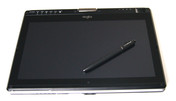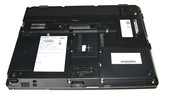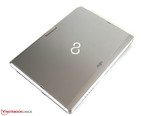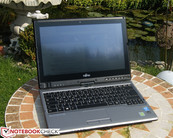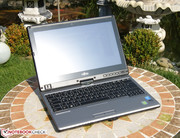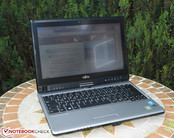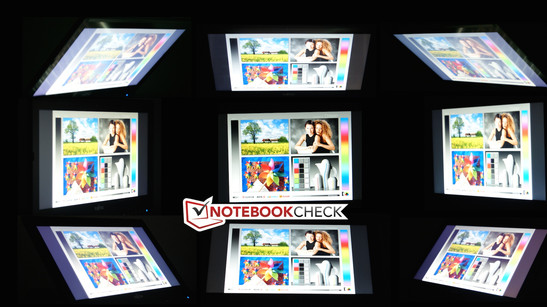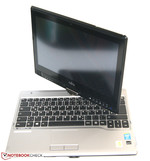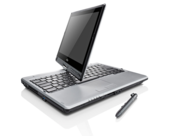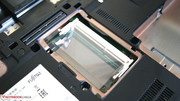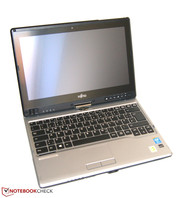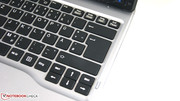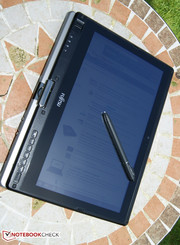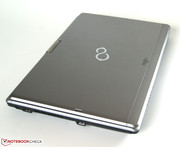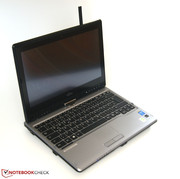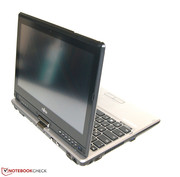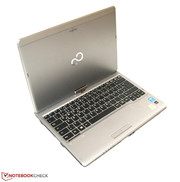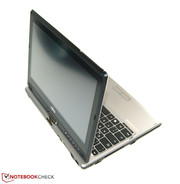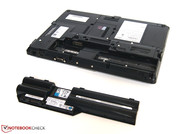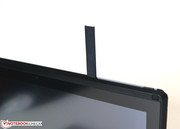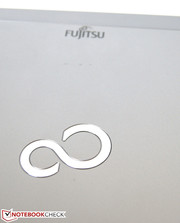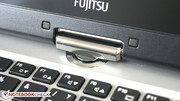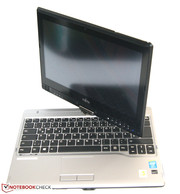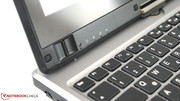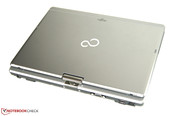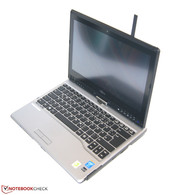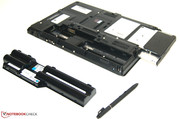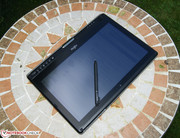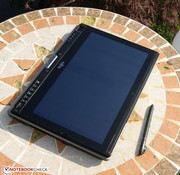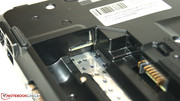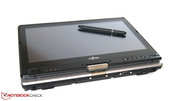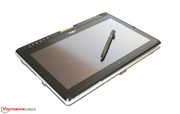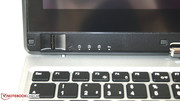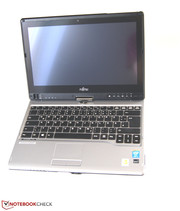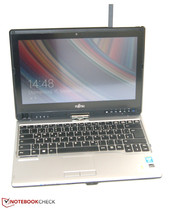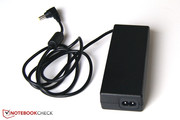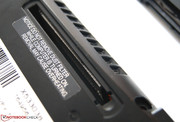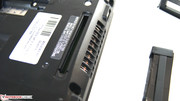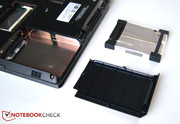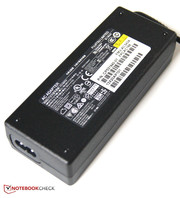Fujitsu LifeBook T734 Convertible Review

For the original German review, see here.
The Fujitsu LifeBook T734 is an old-school convertible. The display unit consists of an IPS panel with support for multi-touch and digitizer pen inputs. To improve the digitizer inputs, the display can be turned by 360 degrees and then folded by 180 degrees to put it on the keyboard. Two UMTS antennas and the SIM slot beneath the battery provide Internet on the road. Inside is a powerful Intel Core i5-4200M processor, 4 GB DDR3 memory and a conventional 500 GB hard drive. We will have a look at the other components and maybe some surprises over the course of this review. Our review sample is available for 1,100 Euros (~$1378), but Fujitsu offers several configurations.
During the review, we will compare the T734 with several other devices. First rival for the LifeBook is the 13.3-inch convertible Dell Latitude XT3 with a powerful Intel Core i7-2640M and equivalent port selection. The biggest difference is the price of around 1,600 Euros (~$2005). The ThinkPad Yoga from Lenovo manages to secure a top spot in our Convertible Top 10. Unlike other Dell and Fujitsu devices, it has a 12.5-inch Full HD IPS display and can be folded back by a tilting hinge and not a swivel joint. There are important differences in terms of CPU and storage solution. Lenovo uses an Intel Core i5-4200U CPU and 128 GB flash storage, while the price of 1,200 Euros (~$1504) is similar to the LifeBook. We also list the Fujitsu Stylistic Q704 with an ULV CPU to show an alternative from the same manufacturer. The last device in this comparison is the HP EliteBook Revolve 810 since HP has been a well-known manufacturer of convertibles for years.
Case
Pick the Fujitsu LifeBook T734 up and you will instantly notice that it is no design notebook from the latest generation of convertibles. The large number of corners, edges and bumps suggest a business device with a big potential for maintenance and replaceable components. Because of the large number of closing edges, you can slightly lift the plastic case. According to Fujitsu, the notebook meets the requirements of the MIL-STD-810 specifications, which include a series of environmental influences.
We have already mentioned that you can easily maintain the notebook, replace components or clean the fan thanks to its maintenance covers. However, you will have to live with a chassis height of 3.5 centimeters (~1.38 inches). Like other touch notebooks it has a wide display bezel. We are speaking about a panel of 27.7 cm x 15.6 cm (~10.9 x 6.14 inches) in a 31.6 cm x 22.3 cm (~12.44 x 8.78 inches) frame. The weight of almost 2 kilograms (~4.4 lbs) is comfortable in the hands and should not be a problem. You can upgrade the port variety by an expansion slot. The manufacturer integrated a swivel joint to improve digitizer and touch inputs. The joints showed some issues after longer periods of use in other reviews, but this is not the case for the LifeBook.
Connectivity
The port layout is sophisticated: Frequently used ports are at the back, and a hot-plugin is supported by a USB 3.0 port at the center of the left side. The 54 mm (~2.12 inches) ExpressCard slot is quite rare, which enables all kinds of ports via adaptors. Fujitsu advertises the optional SmartCard reader, but other possible solutions would be another USB 3.0 port or even several ports with a reduced bandwidth, or the connection for an external graphics card to improve the performance. The latter worked perfectly in our test, more details are available in our review of external graphics cards. The maximum resolution of the integrated HDMI and VGA port is 1920x1080 pixels. The SIM slot is somewhat hidden beneath the battery. The only issue of the port layout is that the two USB ports are above one another, and that you just get one USB 3.0 port. Special features of the connectivity are the UMTS antenna at the display frame, and the digitizer pen, which is attached at the right front.
Communication
The two antennas of the Intel Dual Band Wireless-N 7260 adaptor support a maximum transfer rate of up to 300 Mbps. We test the download speeds in practice with several files of different sizes and measure the average transfer rate. The router is one floor below the review sample in the first test with the competitors Fujitsu LifeBook T734 as well as Apple MacBook Retina 13 (Late 2013). The Fujitsu manages 5.3 MB/s, which is clearly behind the 7.5 MB/s of the MacBook. The difference gets smaller when the router is on the same floor, both notebooks basically manage similar results. The integrated 2 MP webcam takes surprisingly bright and good pictures of the environment with almost authentic colors.
Security
Security is an important topic for Fujitsu. The login can be protected via fingerprint sensor and you can buy the optional SmartCard reader. Furthermore, the device is equipped with the Anti-Theft protection, so you can lock, locate or delete your files at any time. You get a Trusted Platform Module as well as the OPAL encryption for the hard drive. The physical protection is ensured by a Kensington Lock at the back.
Accessories
The box includes a recovery DVD, microfiber cloth, digitizer pen and a strap for the pen. Optional accessories like a docking station or the above mentioned SmartCard reader can be purchased from Fujitsu’s shop. Probably the most interesting accessory is the Port Replicator for 130 Euros (~$163), which provides more ports, including four additional USB 3.0 ports and a DisplayPort with a maximum resolution of 2560x1600 pixels. Further details are available on the product page of the T734.
Maintenance
The Fujitsu LifeBook T734 is more than exemplary with regard to maintainability. Battery and DVD drive can be removed without additional tools, and the DVD drive can be replaced with an optional secondary battery (smaller capacity). Maintenance covers ensure quick access to two additional memory slots, the WLAN module, the hard drive as well as the dust filter. The whole base unit can be removed without any problems, you just have to loosen the surrounding screws. This means it is easy to maintain the device or replace parts if necessary.
Warranty
Fujitsu offers a three-year Collect & Return/Bring-In service for the LifeBook.
Input Devices
Keyboard
The matte black chiclet keyboard has a roughened surface for a favorable typing experience. The keys have a very soft stroke with precise pressure points and do not suffer from flexing. A small issue during intense typing sessions is the audible typing noise, but it is still normal in comparison. There are even some special buttons on the display. All in all a convincing performance.
Touchpad
The situation changes when we look at the touchpad. With dimensions of around 6.7 cm x 4 cm (~2.64 x 1.57 inches), the touchpad is pretty small and as a result multi-touch gestures are not really helpful. The two buttons beneath the touchpad are just as small, but have even pressure points.
Touchscreen / Digitizer
Inputs with the digitizer pen are precise and smooth on the soft display surface. The writing experience is easily sufficient even for longer texts. The digitizer pen itself does not require an additional battery and is made by Wacom. Besides the digitizer pen, you can also use up to 10 fingers for inputs on the multi-touch display. The response is once again very direct and convinces with smooth gestures like scrolling from the sides.
Display
The Fujitsu LifeBook T734 is equipped with a high-quality IPS panel with 1366x768 pixels (aspect ratio 16:9). We can measure an average brightness of 262.8 cd/m², which is a low value within our comparison. Fujitsu’s data sheet promises 300 cd/m², but the device does not reach this value. The Fujitsu Stylistic Q704, for example, has an average brightness of 365.8 cd/m². Unfortunately, there is no optional upgrade for the panel. We can also notice some screen bleeding in the lower part of our matte panel.
| |||||||||||||||||||||||||
Brightness Distribution: 91 %
Center on Battery: 273 cd/m²
Contrast: 1011:1 (Black: 0.27 cd/m²)
ΔE ColorChecker Calman: 4.03 | ∀{0.5-29.43 Ø4.79}
ΔE Greyscale Calman: 2.54 | ∀{0.09-98 Ø5}
Gamma: 2.5
CCT: 6631 K
| Fujitsu LifeBook T734 HD Graphics 4600, 4200M, Western Digital Scorpio Blue WD5000LPVX | Fujitsu Stylistic Q704 HD Graphics 4400, 4300U, Samsung MZNTD128HAGM | Lenovo ThinkPad Yoga HD Graphics 4400, 4200U, Samsung PM841 Series MZ7TD128HAFV-000L1 | HP EliteBook Revolve 810 HD Graphics 4000, 3437U, Samsung MZ7PC128HBFU | |
|---|---|---|---|---|
| Display | ||||
| Display P3 Coverage (%) | 41.85 | 43.87 | 43.9 | |
| sRGB Coverage (%) | 61.8 | 65 | 65.8 | |
| AdobeRGB 1998 Coverage (%) | 43.32 | 45.55 | 45.37 | |
| Screen | -16% | -37% | -14% | |
| Brightness middle (cd/m²) | 273 | 410 50% | 400.5 47% | 434 59% |
| Brightness (cd/m²) | 263 | 366 39% | 370 41% | 414 57% |
| Brightness Distribution (%) | 91 | 82 -10% | 85 -7% | 91 0% |
| Black Level * (cd/m²) | 0.27 | 0.545 -102% | 0.641 -137% | 0.6 -122% |
| Contrast (:1) | 1011 | 752 -26% | 625 -38% | 723 -28% |
| Colorchecker dE 2000 * | 4.03 | 4.57 -13% | 6.19 -54% | 4.84 -20% |
| Greyscale dE 2000 * | 2.54 | 3.74 -47% | 5.4 -113% | 3.69 -45% |
| Gamma | 2.5 88% | 2.61 84% | 2.71 81% | 2.6 85% |
| CCT | 6631 98% | 7108 91% | 5829 112% | 6547 99% |
| Color Space (Percent of AdobeRGB 1998) (%) | 39.19 | 42.96 | 42 | |
| Total Average (Program / Settings) | -16% /
-16% | -37% /
-37% | -14% /
-14% |
* ... smaller is better
Now we have a closer look at the picture itself. The contrast of 1,011:1 is much higher than the guaranteed value of 500:1 from the data sheet, which can also be affected by the low luminance. Dark pictures and movie passages look nice, thanks to a low black value of 0.27 cd/m². CalMAN determines a decent grayscale deviation of 2.54, and the result of the colors is just slightly higher with 4.03. Both results can surpass all the mentioned rivals, and suggest a very good color reproduction in comparison to the sRGB color space.
Outdoor use can be tricky in sunny environments since the anti-glare display creates annoying reflections, in the tablet mode in particular. However, working with the device in the shade and a cloudy sky is not a big problem.
The viewing angle stability is a very important feature for a convertible. Fujitsu equips the LifeBook T734 with a high-quality IPS panel. This means there are just small brightness and color distortions with different viewing angles. However, we can notice a milky veil with angles of more than 45 degrees.
Performance
Our review sample is equipped with an Intel Core i5-4200M, even though we expected a more frugal ULV CPU for this size. Other configurations include i3 and i7 processors, and instead of the conventional 500 GB hard drive you can choose a hybrid hard drive or an SSD. Our LifeBook configuration should be well-suited for most working scenarios, but you can add more options during the purchase if you need to.
| Processor | Memory | Hard Drive | Operating System |
|---|---|---|---|
| Intel Core i7-4600M (2.9 GHz, up to 3.6 GHz, 4 MB) | 4 GB (1 module 4 GB) DDR3, 1600 MHz, PC3-12800, SO DIMM | SSHD, 5,400 rpm, 500 GB / 8 GB SSD cache, 2.5-inch, S.M.A.R.T. | Windows 8.1 Pro 64 bit |
| Intel Core i5-4300M (2.6 GHz, up to 3.3 GHz, 3 MB) | 8 GB (1 module 8 GB) DDR3, 1600 MHz, PC3-12800, SO DIMM | SSD SATA III, 256 GB, 2.5-inch | Windows 8.1 64 bit |
| Intel Core i5-4200M (2.5 GHz, up to 3.1 GHz, 3 MB) | SSD SATA III, 128 GB, 2.5-inch, Opal TCG | Windows 7 Professional 64 bit | |
| Intel Core i3-4000M (2.4 GHz, 3 MB) | SSD SATA III, 128 GB, 2.5-inch | ||
| SATA, 5,400 rpm, 500 GB, 2.5-inch, S.M.A.R.T. | |||
| SATA, 5,400 rpm, 320 GB, 2.5-inch, S.M.A.R.T. | |||
| SATA, 5,400 rpm, 320 GB, 2.5-inch, Opal TCG |
Processor
The Intel Core i5-4200M CPU is mainly used for slightly larger notebooks and provides mainstream performance. The two cores have a nominal clock of 2,500 MHz, which can increase up to 3,000 MHz (multi-core) via Turbo Boost. The rival Lenovo ThinkPad Yoga has a ULV CPU with a TDP of just 15 Watts and therefore a lower nominal clock and Turbo clock. Both the Fujitsu Stylistic Q704 and the HP EliteBook Revolve 810 use this type of CPU as well. Dell's Latitude XT3 is similar to the Fujitsu LifeBook T734 and uses an Intel Core i7-2640M from the old Sandy Bridge generation.
This is an interesting comparison between the frugal ULV processors and the more powerful standard voltage systems. Cinebench R11.5 Multi-Core shows that the Dell Latitude XT3 has a small advantage, despite the older Sandy Bridge architecture, but the ULV models are close. The difference to the weakest CPU inside the Fujitsu Stylistic Q704 is noticeable with 64%. Overall, our review unit is slightly below the average of notebooks with an identical CPU. We could not determine any throttling during the test, the CPU was not able to maintain the maximum Turbo clock for the whole time, but leveled off at around 2,750 MHz. Fujitsu limited the clocks in this case, which also explains the low power consumption. Further details on the individual CPUs are available in our benchmark list of notebook processors.
The Turbo Boost is even available on battery power, so the performance of the Fujitsu is not limited when on the road.
| Cinebench R11.5 | |
| CPU Multi 64Bit (sort by value) | |
| Fujitsu LifeBook T734 | |
| Lenovo ThinkPad Yoga 20CD0038GE | |
| Fujitsu Stylistic Q704 | |
| HP EliteBook Revolve 810 | |
| Dell Latitude XT3 | |
| Fujitsu Lifebook E734 | |
| CPU Single 64Bit (sort by value) | |
| Fujitsu LifeBook T734 | |
| Lenovo ThinkPad Yoga 20CD0038GE | |
| Fujitsu Stylistic Q704 | |
| HP EliteBook Revolve 810 | |
| Dell Latitude XT3 | |
| Fujitsu Lifebook E734 | |
System Performance
The first subjective impression suggests quite a responsive and fast system. Experienced users will quickly miss a fast SSD, but this is an optional extra. The lack of flash storage affects the PCMark 7 results as well; all competitors can manage much higher results thanks to the SSD storage.
| PCMark 7 Score | 2745 points | |
| PCMark 8 Home Score Accelerated v2 | 2386 points | |
| PCMark 8 Creative Score Accelerated v2 | 2482 points | |
| PCMark 8 Work Score Accelerated v2 | 3155 points | |
Help | ||
Storage Devices
The conventional hard drive with 5,400 revolutions per minute manages typical results for this kind of hard drive in CrystalDiskMark. The lowest results within the comparison show the advantages of an SSD. If flash storage is important for a fast workflow, then you can choose between different SSDs at the time of purchase. More detailed hard drive benchmarks are available in our FAQ section.
Graphics
The CPU is equipped with the integrated Intel HD Graphics 4600, which is sufficient for simple office and system tasks. Gaming enthusiasts should not consider this notebook, but casual gamers might be able to play some current titles, at least with the lowest settings. Fujitsu does not offer optional dedicated graphics cards.
We analyze the 3DMark 11 results to compare the performance of our review sample with the rivals. The bad result of just 611 points is striking, which is on a level with the Intel HD Graphics 4400. The reason for this can be the single-channel memory configuration combined with the low clock under load. The average result for the Intel HD Graphics 4600 is 911 points, and our comparison devices confirm the bad result. The Intel HD Graphics 4400 inside the Lenovo ThinkPad Yoga reaches significantly more points (815).
We also test 3DMark 11 on battery power, but there was no noticeable difference, which means you can use the full performance on the road.
| 3DMark 11 - 1280x720 Performance (sort by value) | |
| Fujitsu LifeBook T734 | |
| HP EliteBook Revolve 810 | |
| Lenovo ThinkPad Yoga | |
| 3DMark Vantage P Result | 3077 points | |
| 3DMark 11 Performance | 655 points | |
| 3DMark Ice Storm Standard Score | 38418 points | |
| 3DMark Cloud Gate Standard Score | 3322 points | |
| 3DMark Fire Strike Score | 432 points | |
Help | ||
Gaming Performance
Similar to the other rivals, potential buyers of the Fujitsu should avoid gaming on the device for the most part. However, you should have no problems if you just want to play older titles, but current 3D titles are most likely going to result in dropped frames. We tested three games from the past year. Tomb Raider can be played smoothly with 33 fps if you reduce all settings to the minimum, but we could not find any decent settings for the BioShock Infinite benchmark. It is nice to see that the notebook does not have any problems with Fifa 14, it still managed 42 fps with high settings.
| low | med. | high | ultra | |
|---|---|---|---|---|
| Tomb Raider (2013) | 32.9 | 16.8 | 10.3 | |
| BioShock Infinite (2013) | 23 | 12 | 10.5 | |
| Fifa 14 (2013) | 112 | 64.5 | 41.9 |
Emissions
System Noise
The Fujitsu LifeBook is a very quiet notebook. Still, despite the low noise, you can feel that the fan moves quite a lot of air through the vents on the left side. We can measure up to 30.4 dB(A) while idling, which is reasonable when you consider the components and the dimensions. The HP EliteBook Revolve 810 and the Dell Latitude XT3 are even slightly quieter, but the situation changes under load, where the Fujitsu is exemplary quiet with 34.3 – 35.9 dB(A). Its Fujitsu sibling, the Stylistic Q704, is pretty annoying with up to 46 dB(A) in the same scenario, despite the similar hardware components.
| Fujitsu LifeBook T734 HD Graphics 4600, 4200M, Western Digital Scorpio Blue WD5000LPVX | Fujitsu Stylistic Q704 HD Graphics 4400, 4300U, Samsung MZNTD128HAGM | HP EliteBook Revolve 810 HD Graphics 4000, 3437U, Samsung MZ7PC128HBFU | Dell Latitude XT3 HD Graphics 3000, 2640M, Seagate Momentus Thin ST320LT007-9ZV142 | |
|---|---|---|---|---|
| Noise | -15% | 2% | -4% | |
| Idle Minimum * (dB) | 30.4 | 29.6 3% | 28 8% | 30.8 -1% |
| Idle Average * (dB) | 30.4 | 33.5 -10% | 28 8% | 30.8 -1% |
| Idle Maximum * (dB) | 30.4 | 33.5 -10% | 28 8% | 30.8 -1% |
| Load Average * (dB) | 35.9 | 45.8 -28% | 37.2 -4% | 37.1 -3% |
| Load Maximum * (dB) | 35.9 | 46.5 -30% | 40.3 -12% | 41.7 -16% |
* ... smaller is better
Noise level
| Idle |
| 30.4 / 30.4 / 30.4 dB(A) |
| HDD |
| 31.2 dB(A) |
| DVD |
| 36.5 / dB(A) |
| Load |
| 35.9 / 35.9 dB(A) |
 | ||
30 dB silent 40 dB(A) audible 50 dB(A) loud |
||
min: | ||
Temperature
Thanks to sufficient space inside the case, and the good cooling solution, the Fujitsu LifeBook T734 is conveniently cool, both while idling and under load. We can hardly measure surface temperatures above 33 °C (~91.4 °F), so it is no problem to use the notebook on your lap. The case itself leaves an exemplary impression. The provided power adaptor can reach up to 50 °C (~122 °F) under load, so you should not hide it under a blanket or a cushion.
We use our stress test with the tools Prime95 and FurMark for at least one hour to monitor the temperatures and check for throttling. The components did not get too hot and we could not notice a performance difference in 3DMark 11. We only noticed that the clock immediately dropped to 2,400 MHz after we launched FurMark, which is 100 MHz below the nominal clock.
(+) The maximum temperature on the upper side is 34.3 °C / 94 F, compared to the average of 35.4 °C / 96 F, ranging from 19.6 to 60 °C for the class Convertible.
(+) The bottom heats up to a maximum of 33.6 °C / 92 F, compared to the average of 36.8 °C / 98 F
(+) In idle usage, the average temperature for the upper side is 27.9 °C / 82 F, compared to the device average of 30.3 °C / 87 F.
(+) The palmrests and touchpad are reaching skin temperature as a maximum (34.3 °C / 93.7 F) and are therefore not hot.
(-) The average temperature of the palmrest area of similar devices was 27.9 °C / 82.2 F (-6.4 °C / -11.5 F).
Speakers
One problem of the Fujitsu is the sound quality. The maximum volume is too low, you cannot really hear the individual sound spectrums and the quality is not even sufficient for the occasional music playback. The two speakers should not be used for anything but system sounds, even though the expectations are pretty low to begin with considering the size and the category of the notebook. However, the two microphones left a positive impression (noise reduction). The two stereo jacks can be used to attach external devices.
Energy Management
Power Consumption
The Fujitsu LifeBook T734 only consumes 8.4 Watts when idle, which is around 1 – 2 Watts lower than the competitors. The result of the low consumption could be longer battery runtimes. It is surprising that the device only needs 32.5 Watts under load, so it does not reach the maximum TDP of the CPU. This means the LifeBook consumes more power than the Fujitsu Stylistic Q704 with ULV hardware, but it is more frugal than the rivals from HP and Dell.
It seems that the power adaptor was not adjusted to the low power consumption of the T734. The 90 Watts module is a standard notebook PSU.
| Off / Standby | |
| Idle | |
| Load |
|
Key:
min: | |
Battery Runtime
The Fujitsu is a business device, so the battery should be sufficiently sized. Our review sample is only equipped with one battery, but you can replace the DVD drive with a smaller optional secondary battery to improve the runtimes.
Fujitsu advertises a battery runtime of up to 10.6 hours. Let us have a look at our results.
The idle test simulates the reading of different documents with the minimum display brightness and deactivated wireless modules. The Fujitsu manages a runtime of 12 hours and 46 minutes. This is a good result, all the rivals except for the Lenovo ThinkPad Yoga have to be recharged sooner.
One important scenario is the WLAN test, which simulates web browsing on different websites. Now the situation changes and the Fujitsu is in third place with 6 hours and 25 minutes. The battery runtime is once again not bad and should last a whole business day with a normal workload (combination of web browsing and typing). However, the Lenovo keeps running for another hour and the Fujitsu Stylistic Q704 lasts 25 minutes longer than the LifeBook thanks to its ULV processor. Dell's Latitude XT3 is once again in the last place with only 3 hours and 27 minutes.
We check the runtime under load to conclude our battery tests. The Stylistic Q704, which is also produced by Fujitsu, manages the longest runtime with almost 4 hours. One reason for this result is the frugal CPU architecture. Our review sample, the Lenovo ThinkPad Yoga and the HP EliteBook Revolve 810 are on a similar level with around two hours.
| Fujitsu LifeBook T734 HD Graphics 4600, 4200M, Western Digital Scorpio Blue WD5000LPVX | Fujitsu Stylistic Q704 HD Graphics 4400, 4300U, Samsung MZNTD128HAGM | Lenovo ThinkPad Yoga HD Graphics 4400, 4200U, Samsung PM841 Series MZ7TD128HAFV-000L1 | HP EliteBook Revolve 810 HD Graphics 4000, 3437U, Samsung MZ7PC128HBFU | Dell Latitude XT3 HD Graphics 3000, 2640M, Seagate Momentus Thin ST320LT007-9ZV142 | |
|---|---|---|---|---|---|
| Battery runtime | 28% | 9% | -16% | -49% | |
| Reader / Idle (h) | 12.8 | 9.1 -29% | 13.3 4% | 7.6 -41% | 5.8 -55% |
| WiFi (h) | 6.4 | 6.9 8% | 7.6 19% | 5.3 -17% | 3.5 -45% |
| Load (h) | 1.9 | 3.9 105% | 2 5% | 2.1 11% | 1 -47% |
Verdict
Finally, we want to summarize our results. Right from the start, we were convinced by the reasonable maintainability of the T734. In addition, you get a decent keyboard as well as a good touchscreen. The device is equipped with several security features, so it should be well-suited for business tasks. The number of ports can be expanded via docking port or ExpressCard slot. The integrated IPS panel provides sufficient viewing angles and can even be used outdoors under certain circumstances. We were surprised by the low system noise and the almost non-existent temperature development in particular. You should be able to manage a whole business day on battery power. Drawbacks include the choice of materials, which are neither scratch-proof nor very robust. It is also disappointing that Fujitsu is not able to reach the advertised brightness of 300 cd/m². The speakers are shockingly bad as well.
All things considered, the T734 is a decent business device. Thanks to its bulky, but maintenance-friendly chassis, it has a certain flair that reminds us of a device for tinkerers, so you can probably see it in some informatics courses. The mobility is always guaranteed thanks to the UMTS module, the tablet functionality and the optional additional battery.




